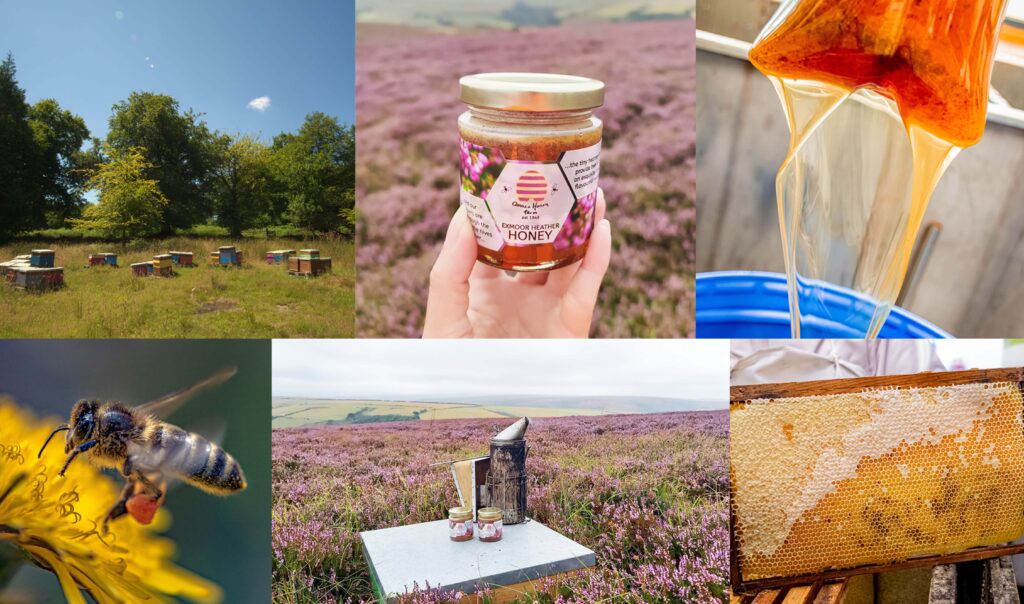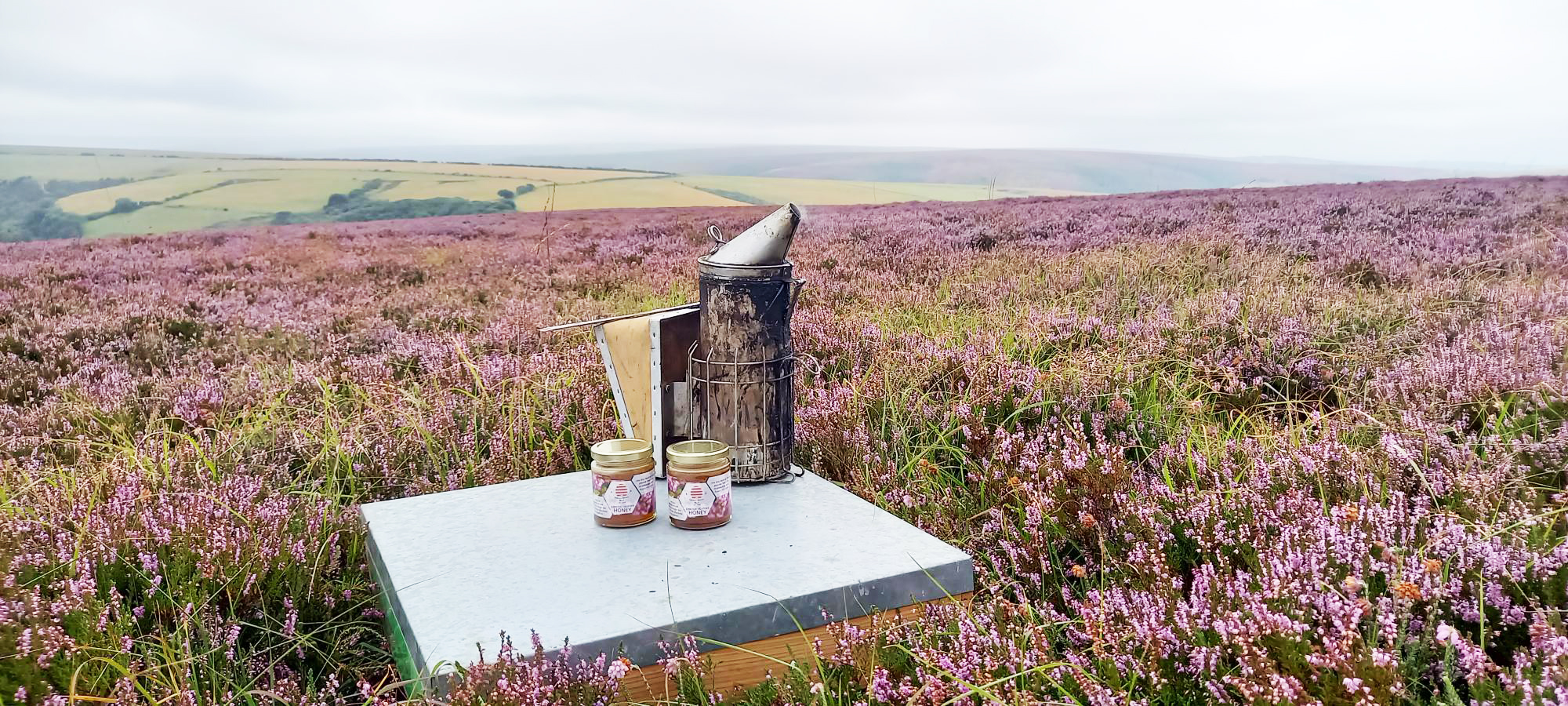Funny old year last year. Said every farmer every year from their first words until they muttered their last. Some have it engraved on their headstone. Well guess what, it was a funny old year last year.
But before we delve into the ups and downs of the farming year let’s just start by saying Hallelujah! Overall we had a good crop of honey last year. As all else crumbled around us the bees did what they do best. Read on for trials and tribulations…
Bee farming, like all farming, is entirely dependent on the weather. You can do everything right and see a threefold difference in the crop you harvest. A bad year at Quince Honey Farm sees 15kg of honey per hive and a good year 35kg. And then there’s the really exceptional years we dream about, and the exceptionally bad ones we don’t. It is so variable that we work on a five year average to have any clue as to how we’re doing.
The North Devon landscape offers our bees seven varieties of honey, and we take some of them further afield for an eighth. We refer to the geographical distribution of flowers around the hives as the nectarscape. The bees’ local nectarscape is, quite literally, a movable feast. Flowers coming in to bloom at different time with the seasons, and the amount of nectar they produce affected daily by the capricious North Devon weather.
In the hope of collecting those seven honeys we have three main harvests a year, and sometimes a fourth. The spring harvest takes place at the end of May. The bees have had around 7 weeks to get a crop of honey. They came out of their winter dormancy in March and we would hope that the weather will be warm enough in April for a go at the Dandelions. We are blessed in the Westcountry with more than our fair share of Dandelions. South West Wales and South West England are unusually yellow in April, a floral side effect of the farming style; grass fields for grazing livestock, too hilly for the plough. As a specialist honey the value of Dandelion is on the higher side, which is lucky because from 1000 hives we produced only one barrel this year (so bad, you may as well not call it a crop at all). Also in spring is the rapeseed, that flowers through April and May. Acres of intense yellow, tall and tightly packed, in flower for 6 weeks or so. The hives are moved specifically to these fields, helping with pollination and producing a pale creamy honey which when spread with butter on farmhouse toast really improves your mornings. And how much did we produce last year? More than the dandelion but still an almost negligible amount, just a few barrels. The biggest spring crop we can hope for is the multi-floral taste of the season known, imaginatively, as spring honey. It’s a real treat containing nectar from many flowers, most notably sycamore, hawthorn, fruit trees, dandelion and sometimes blackthorn. But, alas, just a few barrels again.
So what went wrong? The weather of course. It’s sometimes hard to remember when looking back on the year, but we were wearing woolly hats in May, a month where it could just as easily be T-Shirts. Disaster. Right ok, never mind, summer could be good….
From a freezing spring to a summer drought which broke in the nick of time, near the end of July the weather gave us two short weeks of perfect honey making conditions. And the bees did their thing. The summer crop has much more potential than the spring crop because the hive populations are booming, so many more foragers to collect nectar. As many as 20,000 more per hive available than in April, that difference translates to many kilos of honey potential per hive. In this case 72 barrels in the shed. We were saved, and the paltry spring crop didn’t sting quite as much. Just one more roll of the dice, something we call the heather gamble. You win some, you lose some, but we always play.
Heather honey is famous across the world. Particularly famous is the Scottish stuff, but most UK moorlands have heather, and where there’s heather, there’s beekeepers. The heather honey from different moorlands tastes subtly different to the accustomed taste bud, a phenomenon popularly known as terroir amongst the wine tasting community. Exmoor is a glorious purple in August, but a challenging place for bees to produce honey with the unrelenting Atlantic winds. Nonetheless, we move hives there from the lowlands every year and pray for just a few calm summer days to give the bees a chance. Some years we get nothing and others a few kilos, the honey is so special and the landscape such an irresistible pull that we would never not take the gamble. Last year? No dice. Next year will be the one, you mark my words. The other heather gamble we take is a jaunt to Scotland, higher stakes but better odds. With the help of an indefatigable local lorry driver we take 300 or so hives up the M5 and beyond. It’s a long way to take bees for 8 weeks of heather flower but believe it or not, it’s worth it. And believe it or not the weather is better up there! We have been taking bees to Scotland for three summers now and so far it’s been worth it every time, most years yielding 5 times the crop on Exmoor. And this year was even better, we should have taken more hives!
So all in all, we were pretty happy with the year, getting a decent crop of our favourite honey: the one that is a true taste of North Devon bursting with so many different flowers we can’t name them all.
If only we had a good spring crop as well. We are farmers, we had to end with a moan.
Oh yes, and that fourth honey crop I mentioned. Ivy Honey. A very rare treat for us, just a barrel or two is all we can hope for. It’s collected by the bees in a warm Autumn, and conditions were right this time. We harvest it early the next spring, so for now we leave the bees alone in dormancy.
Fingers crossed.
Blog written by Ian Wallace, Beekeeper and Partner of Quince Honey Farm.

Images: Hives in the summer, Exmoor Heather Honey, Honey filtering, Honeybee on dandelion, Hives in the heather, Honeycomb frame
Photo credits: Karolina Andreasova, Helen Persson and Quince Honey Farm’s Beekeeping team
Thanks to our productive honeybees last year, we are pleased to be able to offer our loyal local customers a significant discount and have dedicated 1 ton of each honey to be sold at the most affordable price we can, to try and do what little we can to support our local community and keep you stocked up with quality local honey. These special prices are only available onsite at Quince Honey Farm, so be sure to pop by and pick up a jar or two (not available online). The Nectary Restaurant will be open so do stay for a homemade meal or cuppa and cake. The shop and restaurant are open Mon-Thurs 10am-4pm, Fri-Sun 9:30am-4pm.
We look forward to seeing you soon and wish you all the best for 2023.

Comments
comments for this post are closed